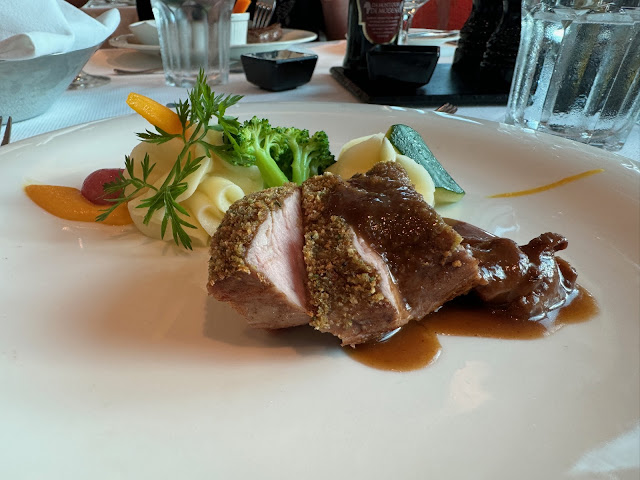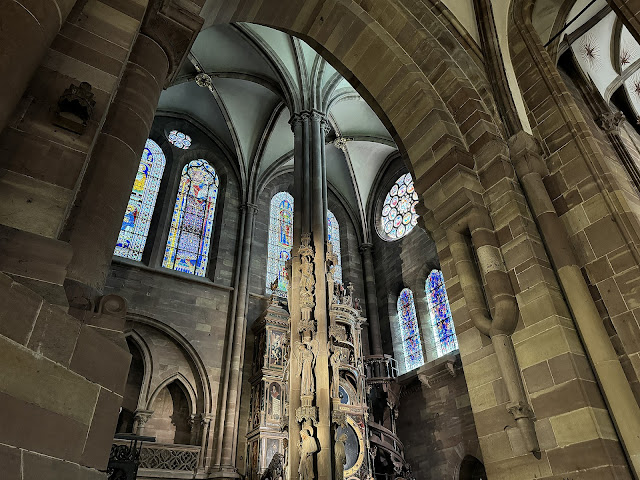I've wanted to visit Strasbourg for years, ever since I saw pictures of it all decorated for Christmas. Suffice it to say, the weather on our afternoon in this Alsatian city was decidedly un-winterlike. In fact, it was the hottest day of the trip - by far.
At breakfast that morning, we learned that due to a potential lock worker strike, our time in Strasbourg would be cut short, but we vowed to make the best of it as our tour bus departed from our spot on the Rhine and made our way to the official seat of the European parliament.
Today, we decided to up our pace and joined the active walking tour. Given the sky-high temperatures and the brisk pace set by the guide, it was quite a sweaty way to begin our time in this lovely city. I literally sweated through my dress, and I wasn't the only one. I have no idea how our tour guide looked fresh as a daisy by the time our time was up.
We were initially dropped off at the lovely Parc de l'Orangerie, where we were introduced to the city's abundant stork population. We were astounded by their nests in the treetops of the avenue outside of the park, as well as all throughout the park. Long story short, I am now obsessed with storks.
From Parc de l'Orangerie, we set a brisk pace past the European Parliament buildings, over a bridge, and then into the heart of the historic part of Strasbourg, zooming past the Cathedral en route to La Petite France, the part of the city most of us are familiar with from pictures on the internet.
At this point, the walking tour was over and we were free to spend the rest of the afternoon however we pleased, the only caveat being that we had to meet up in front of the Cathedral at 1 p.m. for the bus ride back to the boat so that we could be the strike.
Needing a moment to recover from the heat, we wandered slowly through the shopping district looking for a stork Christmas ornament (but didn't find one that wasn't made in China, unfortunately) and then onward to Place du Marche Gayot, a cute little square we'd passed by earlier that had several restaurants. Because it was still fairly early in the afternoon, the most notable of them wasn't yet open, but we were able to sit in the shade at a little cafe and have a drink while we waited for somewhere to open so we could eat a tarte flambée, a dish made famous in Strasbourg. For those of you who've never had one, it's essentially the thinnest pizza you can imagine with ham/bacon, onion, and gruyere cheese. (
Here's a blog post that describes how to make it at home).










Restored and rejuvenated from our lovely lunch in a picturesque French square, we made our way over to the Strasbourg Cathedral (aka Cathedral of Our Lady of Strasbourg). Since that was where we'd been instructed to meet back up with our group, we figured touring it last was the best way to maximize our time since we had far fewer hours available to wander than we'd anticipated. The line to get in was long but not prohibitively so. I think it felt longer than it actually was because there was no shade and it was around 90 degrees.
Some facts and figures about Strasbourg Cathedral:
- Though parts of it are in Romanesque style, it is considered to be among the finest examples of Rayonnant Gothic architecture.
- It was the world's tallest building for 227 years (1647 - 1874).
- Today, it is the sixth tallest church in the world.
- It is the tallest structure built entirely in the Middle Ages.
- In 1988, it was named a UNESCO World Heritage site
We were particularly interested in going inside so we could see the astronomical clock, dating from 1843. This is the third clock in this spot. The first one was built in the 14th century, and the second in the 16th century.
Remember how I mentioned the potential strike and needing to leave Strasbourg early to avoid it?
 |
| Running through Strasbourg to get back to the coach |
Well, despite practically running across the historic city center as a group of 100 or so tourists and getting back to the boat well within the allotted time ... we got caught in the strike.
This meant several hours in the pool and several drinks while we waited to get underway again. Unfortunately, it also meant we probably could have stayed in Strasbourg and continued exploring because it wasn't until sometime around dinner that we actually started sailing toward our next destination.
 |
| Idling on the river for several hours |
 |
Turns out my mascara was not water (or Negroni) proof
|
After dinner - which, as you can see - was lovely and oh-so-tasty - we ventured up to the top deck to enjoy the lovely weather, several glasses of wine, and to chat with some of our fellow passengers.
 |
| Finally underway, en route to our next stop! |














































































